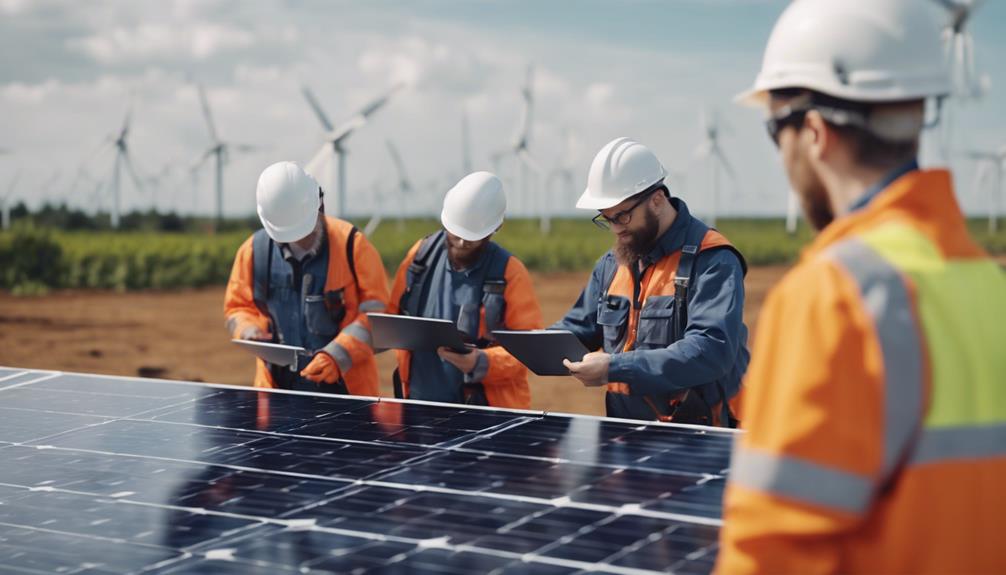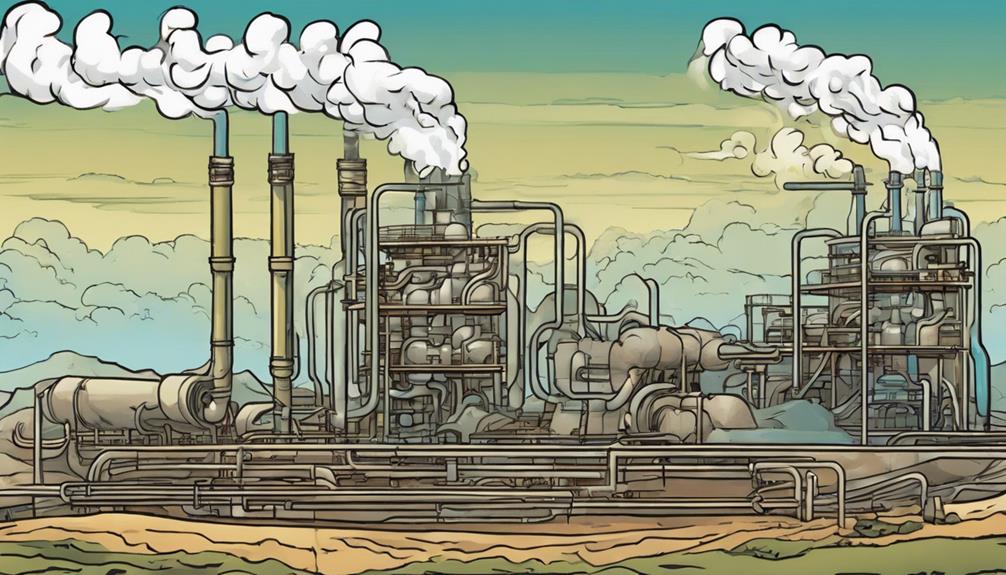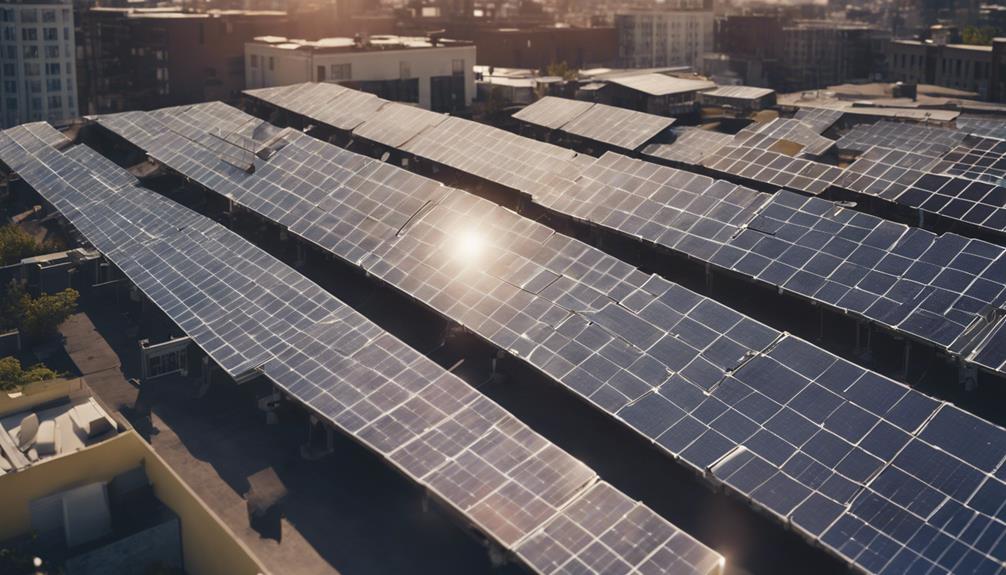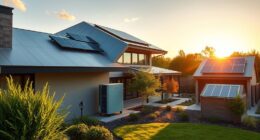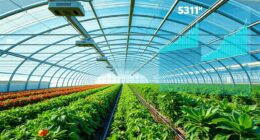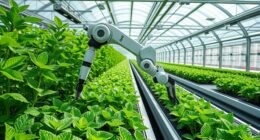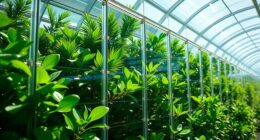Master best maintenance practices for solar farms to boost efficiency and lifespan. Implement regular checks for damage, soiling, and connections. Utilize advanced cleaning methods like robotics for peak performance. Monitor panel health with tracking software and inspect inverters for early issue detection. Address common problems like microcracks promptly to prevent major repairs. Enhance efficiency and cut costs with proper maintenance. Stay ahead with expert consultations for tailored repair strategies. Stay tuned for the latest advancements in solar panel technology to further improve your farm's operations and output.
Key Takeaways
- Regular maintenance prevents costly repairs.
- Utilize monitoring systems for efficient operations.
- Embrace advancements like smart panels for optimization.
- Address common issues promptly to avoid downtime.
- Stay updated on technology for increased efficiency.
Solar Panel Maintenance Basics
Regularly examining your solar panels for physical damage is vital to prevent costly repairs and maximize performance. Solar panel maintenance plays an essential role in ensuring peak energy generation and longevity of your system. By conducting routine checks for microcracks, soiling, and loose connections, you can safeguard your panels from potential issues that may compromise efficiency.
Preventative measures such as cleaning methods using robotics or soapless techniques not only enhance energy production but also extend the lifespan of your solar panels. These simple maintenance tasks can go a long way in preserving the integrity of your system and avoiding unnecessary repair expenses.
Monitoring System Performance
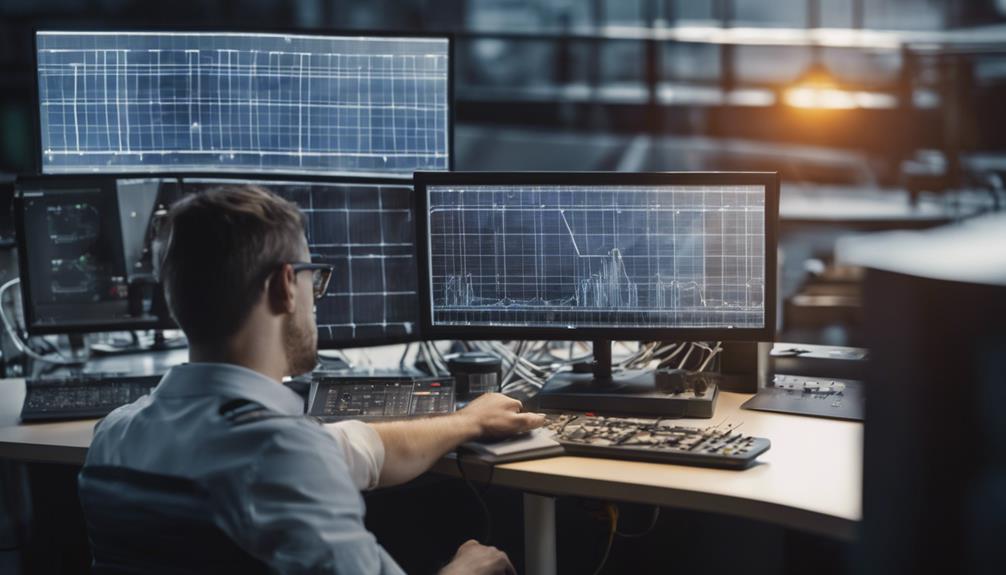
You should prioritize implementing performance tracking software to monitor the energy output of your solar farm efficiently.
Regularly checking the health of inverters is vital to guarantee smooth operations and prevent potential malfunctions.
Analyzing energy production data will help you identify any issues promptly and optimize the overall efficiency of your solar farm.
Performance Tracking Software
Efficiently monitoring the performance of a solar farm through specialized software is important for maximizing energy production and minimizing maintenance costs. Performance tracking software for solar farms plays an essential role in optimizing operations. Here's why:
- Real-time Monitoring: These software solutions track energy production, system efficiency, and potential issues instantly.
- Anomaly Detection: By analyzing data from solar panels, inverters, and weather conditions, the software can identify deviations and predict maintenance needs.
- Optimized Performance: Ensuring the solar farm operates at peak levels by leveraging data insights leads to increased energy yield and cost savings.
- Remote Access and Control: Advanced systems allow for remote management, enhancing efficiency and reducing downtime.
Implementing performance tracking software not only increases energy output but also extends the lifespan of the solar farm infrastructure while reducing operational costs.
Inverter Health Monitoring
How can inverter health monitoring contribute to enhancing the performance of a solar farm?
Inverter health monitoring plays a crucial role in ensuring the efficient operation of solar panels by detecting performance issues early on. By continuously monitoring systems for voltage fluctuations and irregularities, potential problems can be identified promptly, preventing energy production losses and expensive repairs.
These monitoring systems analyze critical data like inverter efficiency, temperature, and power output to guarantee optimal functioning. With the advancement of monitoring technologies, real-time tracking of inverter performance has become feasible, enabling immediate alerts for any anomalies that require attention.
Energy Production Analysis
Effective energy production analysis through monitoring system performance is essential for optimizing solar farm operations and maximizing efficiency. By tracking the output of solar cells and using advanced monitoring systems, operators can identify issues such as shading, module failures, or wiring problems that may impact energy production.
Here are key points to take into account for energy production analysis:
- Track Solar Panel Output: Monitor the performance of solar cells to make sure they're generating the expected amount of electricity.
- Identify Performance Issues: Utilize monitoring systems to detect shading, module failures, or wiring issues that can impact energy production.
- Optimize System Efficiency: Analyze performance data to optimize the system for peak efficiency and troubleshoot underperforming components.
- Predict Maintenance Needs: Regular energy production analysis can help anticipate maintenance requirements and prevent potential system failures in advance.
Common Solar Panel Issues
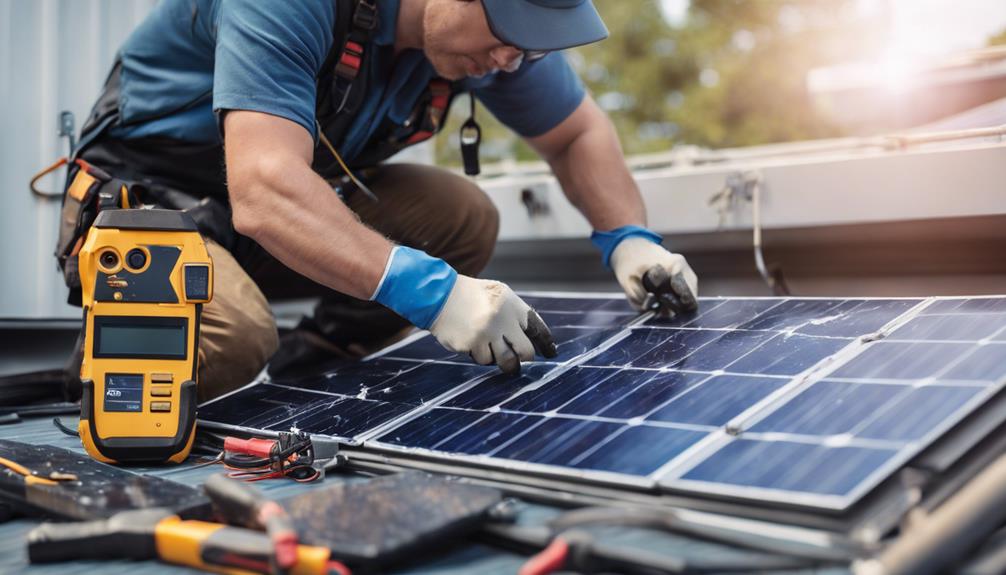
Common issues with solar panels, such as hotspots, microcracks, and soiling, can impact their performance and efficiency. Inverter problems, like overheating or malfunctioning, also play a significant role in the overall functionality of solar panel systems. Additionally, pest damage, whether it be from birds nesting under panels or rodents chewing on wires, can lead to costly repairs if not promptly addressed.
It is essential to conduct regular inspections to check for loose connections, physical damage, and efficiency levels to identify and resolve these common solar panel issues. Monitoring energy production levels and system performance can help in detecting problems early on, preventing the need for major repairs in the future.
Cost of Maintenance and Repair
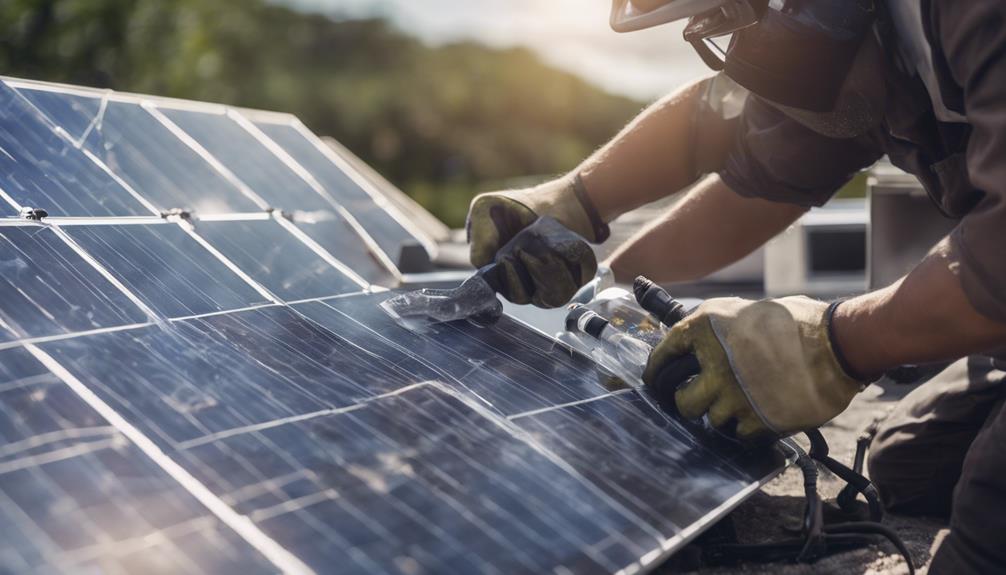
Maintaining and repairing solar panels involves costs that can vary depending on factors such as system size and environmental conditions. To manage these costs effectively, make sure to take into account the following:
- Routine Maintenance Costs: Expect to pay between $400 to $735 for routine maintenance, influenced by the size of your solar system and local environmental conditions.
- Repair Expenses: Repairs can range from $450 to $500, with the extent of damage and type of repair affecting the final cost.
- Invest in Monitoring Systems: Investing in monitoring systems and software can help detect issues early, potentially reducing long-term repair costs.
- Preventive Measures: Proper maintenance and timely repairs are essential. They help prevent minor issues from escalating into major problems, ultimately saving money on extensive repairs or replacements.
Regularly monitoring your solar system's energy production levels and conducting inspections can help assess its health and determine the need for maintenance or repairs.
Cleaning Methods for Solar Panels
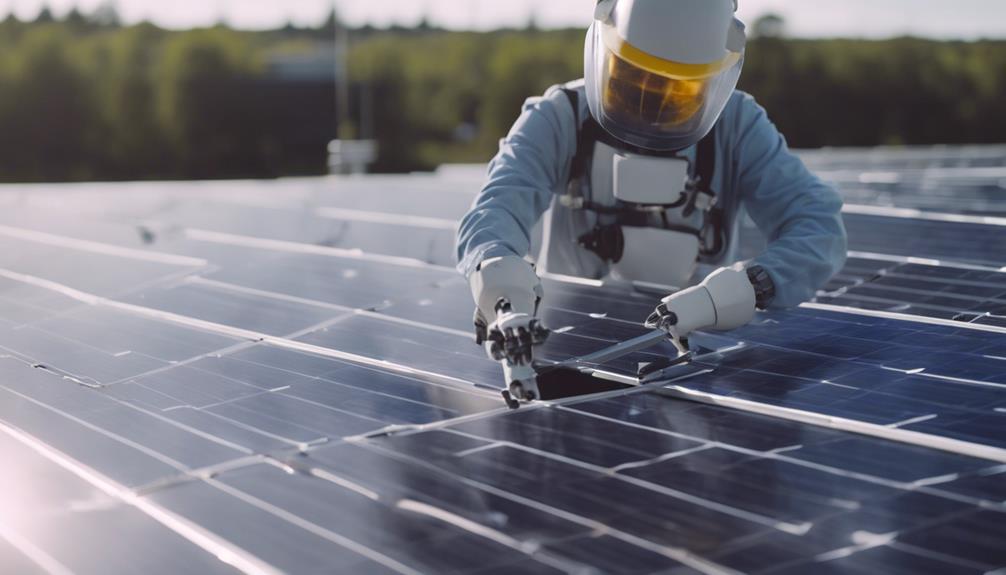
Enhancing solar panel efficiency can be achieved through various cleaning methods that help maintain peak energy production levels.
Manual cleaning with water and a soft brush is a common practice that can boost efficiency by up to 12%.
For a more efficient and water-saving approach, robotic cleaning systems are available, reducing water usage by up to 90% compared to manual methods.
Soapless techniques utilizing water jets or air blowers are both eco-friendly and effective at removing dirt and debris from solar panels.
To further optimize efficiency, consider managing shading through tree trimming or adjusting panel positioning to prevent soiling and enhance energy production.
Regular cleaning maintenance is essential to prevent energy production losses, as studies suggest that panels can experience up to a 25% decrease in efficiency if not cleaned regularly.
Repairing Minor Damage
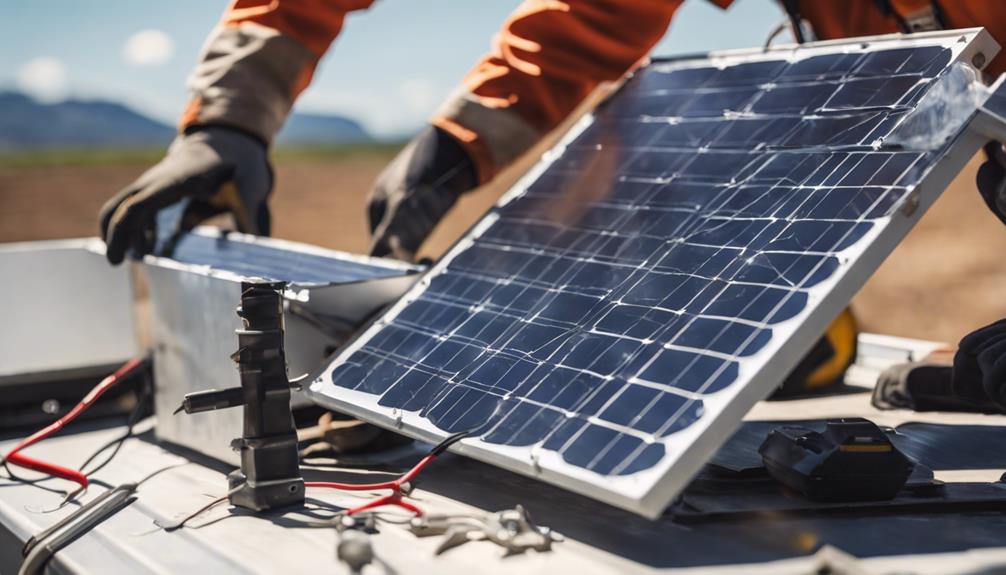
Quality welding techniques can often be utilized to repair minor damage to solar panels, ensuring their structural integrity is maintained. Repairing minor damage promptly is significant as it can prevent further deterioration and maintain the efficiency of the entire solar farm.
Common issues such as small cracks, scratches, or dents can be effectively addressed by trained professionals through welding techniques. It's important to address minor damage promptly to prevent it from escalating into larger, irreparable issues.
Regular inspection and maintenance play an essential role in detecting minor damage early, allowing for timely repairs and avoiding costly replacements.
- Prompt Repairs: Address minor damage promptly to prevent further deterioration.
- Common Issues: Small cracks, scratches, or dents can be repaired through welding techniques.
- Prevent Escalation: Timely repairs prevent minor damage from becoming irreparable issues.
- Regular Maintenance: Conduct regular inspections to detect minor damage early and avoid costly replacements.
Consulting Professionals for Repairs
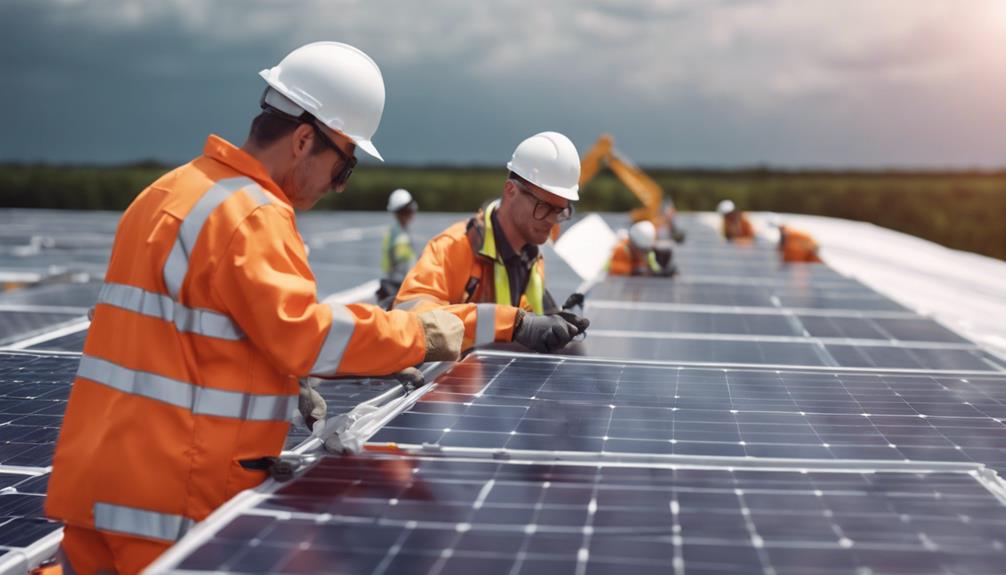
Addressing more intricate issues in solar farm repairs often requires consulting specialists who bring expertise in diagnosing problems and recommending effective solutions. These experts have the knowledge and experience needed to identify complex issues within the solar farm system and provide tailored repair strategies.
By hiring experienced professionals for repairs, you can prevent further damage and ensure the best performance of your solar farm infrastructure.
Professional consultation is vital for accurately determining the extent of damage and selecting the most cost-effective repair options. Working with experts in the field can help you avoid mistakes that could compromise the efficiency and longevity of your solar farm.
Their insights and recommendations play a pivotal role in maintaining the functionality and productivity of your solar energy system. Thus, when faced with intricate repairs or maintenance tasks, entrusting the job to skilled professionals is a wise decision that can safeguard your investment in solar energy.
Emphasis on Proper Maintenance
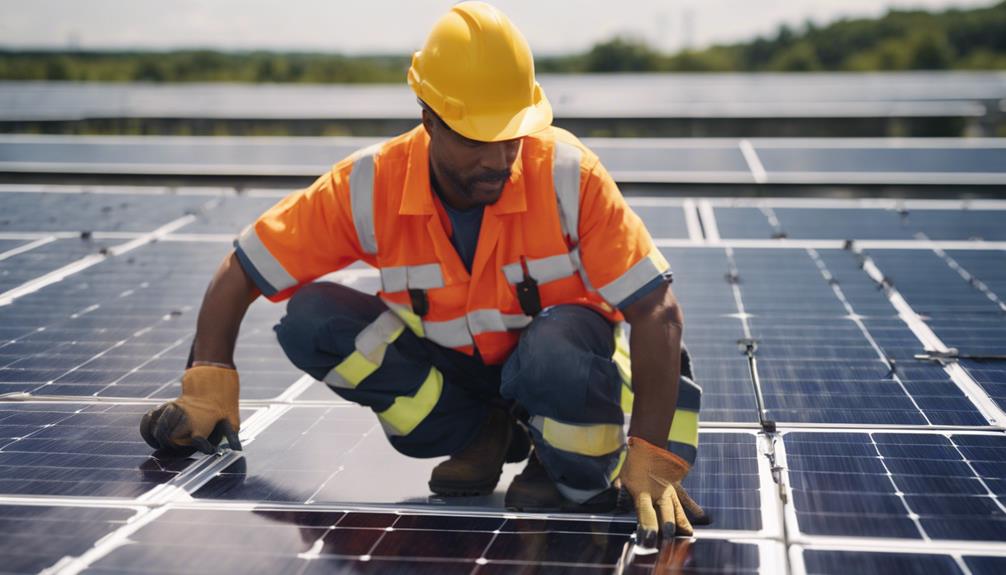
Prioritizing regular upkeep is vital for maximizing the efficiency and longevity of your solar energy system. By following a structured maintenance plan, you can guarantee your solar farm operates at peak performance levels for years to come.
Here are some key reasons why proper maintenance is essential:
- Lifespan Extension: Regular maintenance can prolong the lifespan of solar panels by up to 25 years, allowing you to maximize your initial investment.
- Increased Efficiency: Proper maintenance can enhance energy production efficiency by up to 30%, leading to higher energy yields and cost savings.
- Prevent Decrease in Production: Neglecting maintenance can result in a 30% decrease in energy production over time, impacting your overall system performance.
- Early Issue Detection: Monitoring system performance helps detect issues early, enabling timely repairs and maintenance to prevent more significant problems down the line.
Investing in routine maintenance not only saves you money in the long run by avoiding costly repairs but also ensures your solar farm functions optimally throughout its lifespan.
Importance of Regular Cleaning
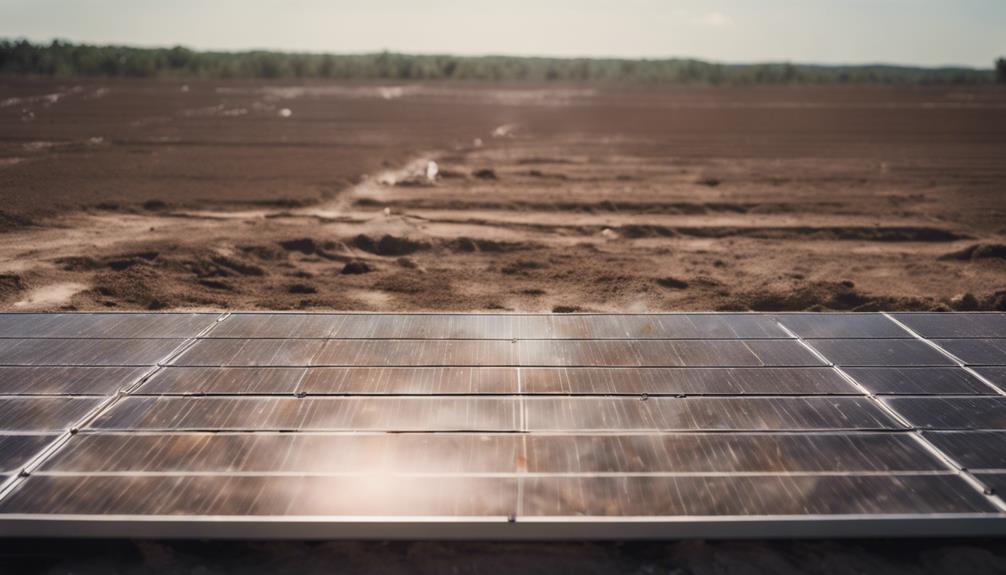
Regular cleaning of your solar panels is important for maintaining peak energy production. By removing dirt and debris that obstruct sunlight absorption, you can increase efficiency by up to 20%.
Following recommended cleaning frequencies and methods guarantees your solar farm operates at its best performance levels.
Cleaning Frequency
To maintain peak energy production from your solar panels, ensuring a regular cleaning schedule is vital. Regular cleaning can significantly impact the efficiency of your panels, with potential energy production improvements of up to 12%.
Factors like dust, pollen, bird droppings, and pollution can reduce panel efficiency and necessitate more frequent cleaning. The recommended cleaning frequency for solar panels typically ranges from every 6 months to 1 year, depending on the location and prevailing climate conditions.
Neglecting regular cleaning can result in decreased energy output, the formation of hotspots, and potential long-term damage to the panels. To ensure thorough and efficient maintenance, consider utilizing automated cleaning systems or professional cleaning services.
Optimal Cleaning Methods
For the most effective maintenance of your solar panels, implementing best cleaning methods is important to guarantee peak performance and efficiency. Regular cleaning plays a pivotal role in increasing solar panel efficiency by up to 20% as it eliminates dirt, dust, and debris that obstruct sunlight.
Manual cleaning with water and a soft brush or automated robotic systems are common methods to maintain cleanliness. Opt for soap-free cleaning techniques using water alone or rainwater harvesting to effectively remove dirt without leaving performance-hindering residue.
Additionally, consider optimizing shading through strategic tree trimming or panel positioning to reduce the frequency of cleaning and maximize energy production.
Monitoring energy production levels before and after cleaning allows you to assess the impact of maintenance efforts on overall panel performance. By incorporating these premium cleaning methods, you can ensure that your solar panels operate at their full potential, contributing to a more sustainable and efficient solar farm.
Advancements in Solar Panel Technology
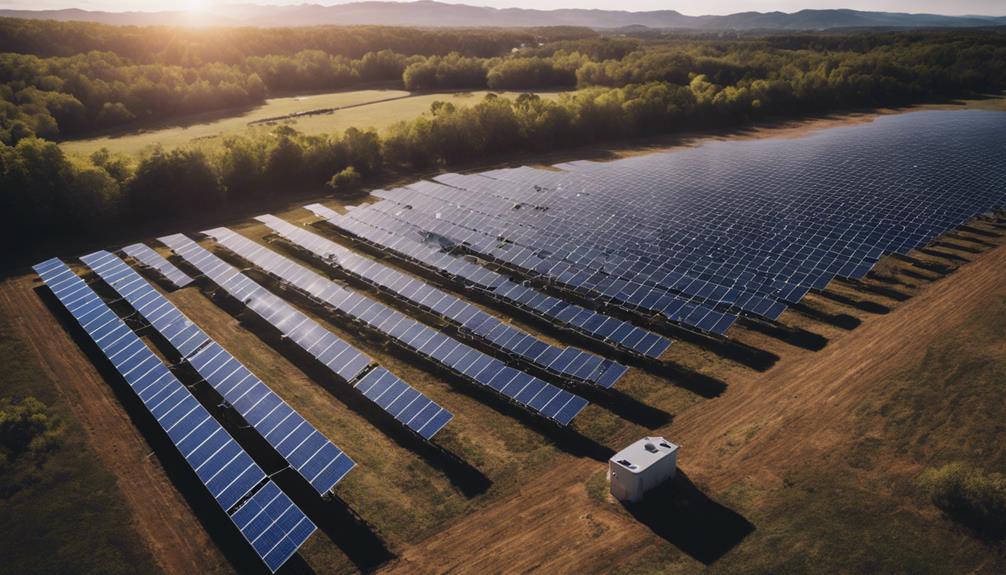
With advancements in solar panel technology, the efficiency of solar panels has increased by over 40% in the last decade, thanks to improvements in materials and manufacturing processes. These advancements have brought about several key innovations shaping the future of solar energy:
- Bifacial Solar Panels and Solar Tracking Systems: These technologies have notably enhanced energy production and overall performance by capturing sunlight from both sides of the panel and adjusting their orientation to follow the sun's path.
- Thin-Film Solar Panels: Growing in popularity due to their flexibility, lightweight design, and potential for integration into various surfaces, thin-film panels offer versatility in solar installations.
- Smart Solar Panels: Equipped with sensors and AI algorithms, smart panels can optimize energy production by autonomously adjusting tilt angles and tracking sunlight throughout the day.
- Perovskite Solar Cells: Emerging as a promising innovation with higher efficiency rates than traditional silicon cells, perovskite cells hold great potential for advancing the efficiency and affordability of solar energy in the future.
Frequently Asked Questions
What Is the Life Expectancy of a Solar Farm?
The life expectancy of a solar farm typically ranges from 25 to 30 years. Regular maintenance, quality components, and favorable weather conditions can help extend its lifespan. Upgrading or replacing parts can also enhance performance over time.
What Is the CSP Best Practices Study?
The CSP Best Practices Study is a research project that identifies and promotes industry-wide best practices for solar farm repairs. It aims to enhance efficiency, safety, and quality by analyzing past cases to develop standardized solutions.
How Much Maintenance Does a Solar Farm Need?
Solar farms typically need routine maintenance every 1-3 months for best performance. Costs can range from $5,000 to $10,000 per megawatt yearly. Inspections for dirt, shading, and wiring issues are essential to prevent downtime and maximize energy production.
Which Four-Four Type of Maintenance Process Is Required in the Solar PV System?
To optimize peak performance from your solar PV system, you need to incorporate corrective, preventive, predictive, and proactive maintenance. Each type serves a crucial role in optimizing energy output, minimizing downtime, and boosting overall efficiency.
What are the best practices and advancements in solar farm repairs that can improve the ROI of a solar farm?
When it comes to maximizing the ROI of a solar farm, staying up-to-date with modern solar farm advancements is crucial. Implementing the best practices for solar farm repairs, such as using advanced monitoring systems and rapid panel replacement techniques, can significantly improve efficiency and reduce downtime, ultimately leading to higher returns.
Conclusion
Now that you've learned the basics of solar panel maintenance and repair,
it's time to put that knowledge to use and guarantee your solar farm continues to operate at its best.
By monitoring system performance, addressing common issues, and staying up-to-date on advancements in technology,
you can keep your solar panels running efficiently and effectively.
Remember, proper maintenance and regular cleaning are key to maximizing the lifespan and energy output of your solar farm.
Happy repairing!
